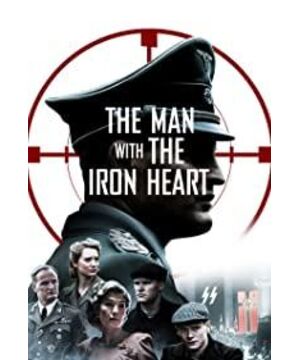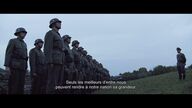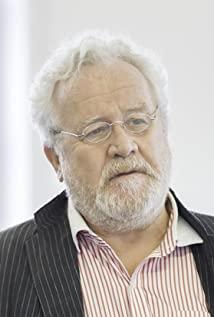Movie length announced by IMdB: 120 minutes
Theatrical version movie duration: 100 minutes
First of all, why are there two versions, because not only the length of the edited movie is different, there are also many changes in many places. I first watched the 100-minute version in the theater, and then watched the 120-minute version at home. I compared it and remembered. Please correct me if you are unclear.
1. At the beginning of the film at 04'00, when Heydrich was serving in the naval base, he played the violin and performed fencing training. There was no 100-minute version. Instead, there was a subtitle "In 1929, Heydrich was still serving in the naval base", and then he picked up his lover Christina at the train station to come to him.
I personally think this paragraph is still very important to explain Reinhard Heydrich's character background and background. Heydrich was born in a musical family. His father Richard Bruno Heydrich (Richard Bruno Heydrich) was an opera singer and composer, and Grandpa was the dean of the famous Royal Academy of Music in Dresden. The name Reinhart (Reinhart) comes from a tragic hero in an opera written by his father (perhaps the source of the opera he read before his death?), and his middle name Tristan comes from his father The beloved Wagner opera classic "Tristan und Isolde" (Tristan und Isolde). So his origin is not strictly speaking at the bottom, and he has cultivated excellent music literacy since he was a child. And I think the fencing scene shows that Heydrich was very fierce in his early years, full of revenge and unscrupulous winning mentality. When he is in the upper hand, he keeps pushing his opponent out of bounds without stopping, and when he is disadvantaged, he uses serious violations. Pushing and pushing people and other means. This paragraph is actually a blend in with a good plot at the beginning, and the 100-minute version may not be shown because it feels unnecessary.
2. 05'49 Unspeakable shots of Heydrich and his lover Christina.
This paragraph mainly answers two questions from the judge in the military court: "Did you have sexual relationship with this young woman?" and "She said you two are engaged." The answer to both questions is yes, because the unspeakable lens focuses specifically on the engagement ring on Christina's middle finger. So Heydrich may unilaterally ruin the marriage contract because he met Lina. The fact is that on December 6, 1930, the 19-year-old Lina met Heydrich for the first time. The two announced their engagement on December 18, but Christina had been dating Heydrich for several months. It was a flash marriage that was faster than a blitzkrieg. Therefore, it is not difficult for Christina to send him to the military court under anger and anger.
3. 10'00'' Part of the 100-minute version of the conversation between Heydrich and Lina on the train is not available.
When Lina took Heydrich to meet her parents by train, she mentioned that she was a member of the Nazi Party and asked Heydrich if he minded this. The 100-minute version of Heydrich answered "Don't mind." The 120-minute version of Lina said: "You have to read the book he wrote." Heydrich asked "What book?" Lina was surprised to say that Heydrich had never heard of Hitler's autobiography "My Struggle" ( Mein Kampf) and told him that he still has a lot to learn. The important point of this passage is that Heydrich was not a Nazi at the beginning. He was completely in desperate career after being dismissed by the Navy and his future was hopeless. It was Lina who introduced him to the rapidly rising Nazi Party and repeatedly encouraged Heydrich. I hope to look for career opportunities in Himmler's newly formed SS.
4. 11'50''-12'00'' Heydrich hosted the flag raising ceremony at the naval base.
It is a simple ten seconds that Heydrich ordered everyone to raise their guns, salute, and raise the flag. The seemingly dispensable section, in fact, the point is that the national flag raised by Heydrich in salute at this time is a black, red and yellow tricolor (basically the same as the current German flag), which was during the Weimar Republic in 1919-1933. The national flag once again proved that he was not a Nazi in the beginning. From January 30, 1933, the official flag recognized by the Nazi Party after the election was changed to only the black, white and red Empire tricolor and the swastika in the middle. At the back of the film, after the SS cleaned the stormtroopers and shot down the stormtrooper chief of staff Ernst Rohm who had dinner with Himmler and Heydrich in the "Night of the Long Knives", there is a scene It was the black, red and yellow tricolor flag that was burned out during the Weimar regime, marking the complete transformation of the Heydrich camp.
5. 22'30'' Unspeakable scene with his wife Lina.
6. 23'50'' Heydrich and Lina took their eldest son to the Nazi parade. The 100-minute version missed Lina pointing to Hitler’s portrait and told the eldest son Klaus that this is the future leader of Germany and he has been appointed as chancellor. (This should be the celebration parade launched when Hitler officially took office as Chancellor in 1933).
7. 27'00'' After the birth of Heydrich's second son, he held a birthday party. Simtdile came to attend a gathering of relatives and friends and had a conversation with Lina.
The important thing is to show the close relationship between Himmler and the Heydrich family. It is here that the English film title "tHe Man witH tHe Iron Heart" corresponds to the original novel name "HHhH". The four Hs in Laurent Binet's original work refer to "Himmlers Hirn heißt Heydrich" which means "Himmler's brain is called Heydrich (Himmler's brain is called Heydrich)". It is estimated that the English film title corresponds to the original famous title, so the four Hs in "the Man with the Iron Heart" are used. Because the 100-minute version does not have this paragraph, it naturally cannot correspond to the title of "Iron Heart Man", so the Chinese title It can only be translated as "Assassination of the Gestapo". (I have to complain about the title. Heydrich is not an ordinary Gestapo at all. As the second SS person behind Himmler, the RSHA under his command covers the Gestapo, the criminal police force and the SS Military Security Department and other important departments). Also, here shows the image of Heydrich who was a very good father and a good father at the beginning of his family life. Later, the relationship with his wife Lina cooled down. Because of the lack of this paragraph in the 100-minute version, it was directly cut to the daughter-in-law and the baby Heydrich. He was not there, but was busy watching the video of the invasion of Poland. In fact, the daughter-in-law here should have given birth to her fourth child. If she was so indifferent at the beginning, then Lina would not marry him.
8. 31'00'' In the brothel where the German Wehrmacht general went to, there was a scene showing the lobby of the brothel (please imagine for yourself). The 100-minute version was changed to lead directly into the room.
9. 35'00'' Heydrich taught his son to play the piano and told his wife that he had been appointed by Hitler as the acting governor of the Protectorate of Bohemia-Moravia (part of today’s Czech Republic) in the German occupied territories. The wife was surprised that the husband hadn’t mentioned such an important appointment for a month. From the wife’s suggestion in the original career to the housewife who kept her empty boudoir alone, it also showed that the close relationship between the two has ceased.
10. 52'00'' Heydrich's deputy Muller had a period of Heydrich's fencing practice before reporting to him the progress of the investigation of the parachute hanging from a tree near Pilsen.
Because I didn't see this paragraph in the 100-minute version, I reported it directly. I wondered what Heydrich did without a military uniform and a jumpsuit... It turned out to be a fencing suit.
11. 63'00'' Young, Joseph, and the last remaining Moravek of the underground resistance group "Three Kings" met in the outskirts stables.
The 100-minute version cuts directly to Moravek’s arrival at the stables to set up the task. The 120-minute version of Joseph’s male host (who later took poison and committed suicide with his son) drove Joseph to the stables. While the two chatted and waited, Young sniffed Joseph the lavender shampoo used by his girlfriend Anna to wash his hair.
The film here is slightly different from history. One of the "Three Kings" Joseph Masin (Josef Masin) refused to explain and was executed by Heydrich. The facts are even more painful. He has been tortured twice to extract a confession. Attempt to commit suicide, but was tortured until after Heydrich was assassinated before being shot in revenge.
12. 68'00'' On the eve of the decision to carry out the assassination, Young's girlfriend, after swinging in the room to show him, asked how Qi Yang and Joseph met.
There is no paragraph in the 100-minute version. It is also mentioned that Joseph is a Slovak (Jan is a Czech), and the two met on their way to Krakow, Poland to join the Freedom Army two years ago.
Since the 100-minute version does not have this short section, when the end of the church is underground, the two raised their guns and prepared to kill themselves, Yang said, "Krakow, remember?" The 100-minute version did not have the foreshadowing of the previous article, which is a pity. Another point that may be over-interpreted by me is that the director here specifically mentioned that Joseph is a Slovak, as if to justify them. The general historical concept seems to be that during the Nazi German occupation, the Czechs fought hard, while the Slovaks tended to cooperate with the occupying forces. History has not always been black and white. Slovaks were among the performers of assassinations here, and Karel Curda, who finally betrayed everyone after the Nazis set off wild revenge, was a Czech. Perhaps the director would like to point out that all countries and nations had rebels and collaborators at the time, thus rectifying Slovakia's name.
13. 88'00'' The female members of the resistance organization of Joseph's family had a conversation with their young son before they went to church to bring them supplies.
There is no paragraph in the 100-minute version. While the child was playing board games on his own, he asked his mother where all the "cousins" had gone. The mother suddenly became severe and warned him not to mention this. The young children inferred from this that the "cousins" were not ordinary people. Indirectly know that their hiding place is in the church.
14. 93'00'' After being injured in the explosion, Heydrich finally provided Himmler with the so-called "Final Solution to the Jewish Problem" and then closed his eyes.
The 100-minute version I remember so clearly that Lina saw Heydrich's last breath, said "no" and sobbed slightly. But the 120-minute version of Lina did not speak, as if she expected the arrival of this moment.
The 120-minute version at the end of the film ends with three sentences: "Heydrich was the highest-ranking Nazi officer assassinated by the resistance organization during World War II. Hitler once told Himmler that Heydrich’s death was greater than the loss in the war. Heydrich The next target of action was originally Paris." Presumably, as a French director, Cedric Jimenez's intention of this last sentence can better arouse the French's resonance with the motives of this assassination. The 100-minute version ends with the history of the Kopledice Massacre and International Children’s Day.
View more about The Man with the Iron Heart reviews











